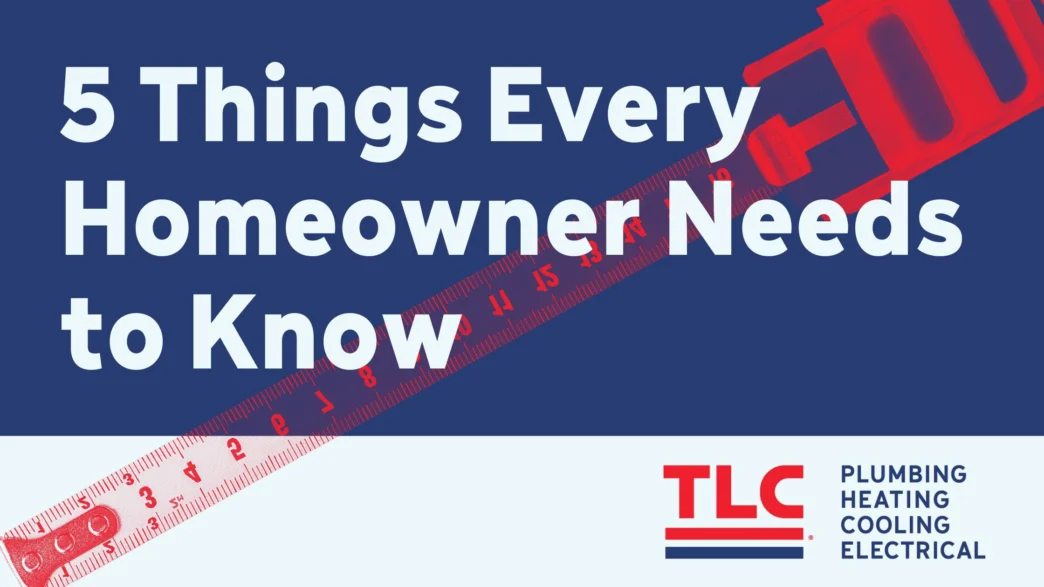Whether you just moved into a new place or have been settled for a while, you need to know these five things about your house. Some of them will save you in an emergency like a burst pipe. Others help you know how to plan and budget for future home needs.
5 Things You Need to Know About Your House
1. Know how to find your water shut-off valve
This is one of the most important things to know about your house! If a pipe, washing machine hose, or swamp cooler line leaks or bursts, you need to stop the flow of water immediately. You’ll do this by turning off your home’s shut-off valve.
The shut-off valve is usually located in a bathroom under a sink, near a toilet, or near the water heater. It should be easy to shut off the water once you find this valve. If you have a hard time finding it, next time you have a TLC plumber out, ask them to find and label it for you.
It’s also important to shut off the water when you go on vacation. If a leak happens while you’re away, it could be days or even weeks before the leak is found. The water damage to your home and belongings can be devastating. The best prevention is to turn off the water shut-off valve before you leave.
2. Know where your electrical panel is located
We’ve all experienced the sudden blackout that comes from running the microwave, the toaster, and the blender all at the same time. Your electrical panel is designed to shut off sections of your electrical system that are overloaded or short-circuiting. You’re probably used to hearing this called “tripping a breaker.” As annoying as a tripped breaker can be, it’s an important part of keeping you and your family safe.
You need to know the exact location of your electrical panel so that you can reset tripped breakers. You might also need to reset breakers after a power outage.
You can usually find the gray electrical panel mounted on the wall in one of the following locations:
- Closet
- Hallway
- Outside Wall
- Garage
- Pantry
Pro Tip
If you’ve got a breaker that keeps tripping even when you use fewer appliances, call an electrician. You might have a short-circuit, an overloaded circuit, or your panel might be malfunctioning.
3. Know how to locate drain cleanouts
A drain cleanout makes it easy for a plumber to clear your main sewer line when it’s clogged. It allows your plumber to send a camera into the sewer line and find out exactly what the problem is and what equipment is needed to clear the blockage. It also saves you labor costs.
Not every home has drain cleanouts, but it’s easy to find out if you have them. Drain cleanouts are always located outside, usually in the front or back yard. They are capped pipes that stick up out of the ground a few inches. A quick walk around the outside of your house should tell you if you have cleanouts.

If you don’t have cleanouts, it’s not the end of the world. Sewer line clogs can still be fixed, but it usually involves going in through the roof or removing the toilet. Knowing if you have cleanouts before you call a plumber makes the job go more quickly and helps your plumber know what to expect.
4. Know whether you have Kitec or polybutylene plumbing
Kitec and polybutylene plumbing are bad words to homeowners and plumbers. Why? Because this type of plumbing is good at one thing: breaking. All plumbing eventually wears out and needs to be repaired or replaced, but Kitec and polybutylene pipes don’t have to be old to crack, leak, or even burst! The only way to prevent the problem is to replace all the plumbing in the house.
So how do you know if you have Kitec or polybutylene plumbing? Check under the sinks in your home or in your boiler room if you have one. Kitec pipes are orange and blue, and polybutylene pipes are gray, as pictured below.

Kitec Plumbing

Polybutylene Plumbing
There’s no need to panic if you do have Kitec or polybutylene plumbing. Your plumbing will need to be replaced eventually, but you probably have time to make a plan. Work closely with a plumber to get an estimate for replacing it. Make sure to get it inspected regularly so that you are informed on the best time to replace it.
5. Know how old your heating and cooling equipment is
Your heating and cooling system is a major investment, so if it fails unexpectedly, it can be quite a financial shock. Luckily, refrigerated air systems, swamp coolers, and furnaces have a fairly predictable life span. By finding out the age of your equipment, you can know approximately how much time you have to save up to replace it. The same is true about your water heater.
The Average Lifespan of Home Comfort Systems:
- Refrigerated air conditioner: 15 – 20 years
- Furnace: 15 – 20 years
- Swamp cooler: 10 – 12 years
- Water heater: 10 – 12 years
To find out how old your home equipment is, look on the unit itself for a sticker that has the serial number. This will usually have a date on it telling you when it was installed. If it doesn’t, you can go onto the manufacturer’s website and search for your equipment’s serial number.
Pro Tip
Regular maintenance helps your equipment make it to it’s full lifespan and beyond! If you’re not sure what kind of shape your equipment is in, get professional out to inspect and maintain it.
The bottom line is…
Whether it’s knowing when to replace your AC or how to stop a flood in your house, these five things will help you stay ahead of home planning and emergencies. If you need any help locating your electrical panel or water shut-off valve or you would like a plumber to evaluate your system, we’re here for you. Schedule online or give us a call at 505-761-9644. Have questions? Ask a pro today!

